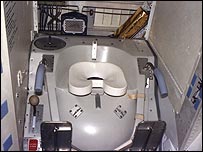DISCOVER MAGAZINEより抜粋
1 Nearly every astronaut experiences some space sickness , caused by the wildly confusing information reaching their inner ears. In addition to nausea, symptoms include headaches and trouble locating your own limbs. Just like college, really.
2 And those are the least of your worries. In weightlessness, fluids shift upward, causing nasal congestion and a puffy face; bones lose calcium, forming kidney stones; and muscles atrophy, slowing the bowels and shrinking the heart .
3 At least you’ll be puffy, constipated, and tall: The decreased pressure on the spine in zero-g causes most space travelers to grow about two inches.
4 Lab rats sent into space during midpregnancy, while their fetuses’ inner ears are developing, spawn some seriously tipsy babies (pdf).
5 No humans have yet been conceived in space, so we can only imagine.
6 So that’s what it takes: A 2001 study showed that astronauts who snored on Earth snoozed silently in space.
7 But astronauts sleep less soundly ; 16 sunrises a day throws a major wrench into their circadian rhythms.
8 And Ziggy played guitar. At the start of the workday on the space shuttle, mission control in Houston broadcasts wake-up music, usually selected with a particular astronaut in mind. On the all-work, no-play International Space Station, crews wake to an alarm clock.
9 If you are ever exposed to the vacuum of space without a suit on, don’t hold your breath: Sudden decompression would cause your lungs to rupture.
10 In addition, water on the tongue, in the nose, and in the eyes would boil away. This actually happened in 1965, when a space suit failed during a NASA experiment and the tester was exposed to a near vacuum for 15 seconds.
11 Contrary to Hollywood, though, you wouldn’t explode. Lack of oxygen in the blood is what would kill you, but it would take about two minutes.
12 More explosion paranoia: Virgin Galactic, Richard Branson’s space-tourism company, reportedly considered barring women with breast implants due to fears that they might blow up.
13 John Glenn found it hard to choke down his food, but not because of the lack of gravity: Early astronauts relied on aluminum tubes of semiliquid mush, food cubes, and dehydrated meals.
14 Today astronauts can spice up their meals with salt and pepper—in liquid form. Sprinkled grains would float away, tickling noses and clogging vents.
15 Missing something? Those vents on the space shuttle and International Space Station serve as the lost and found, sucking up anything that’s floating about unsecured.
16 The shuttle commode requires that astronauts align themselves precisely in the dead center of the seat. A mock-up of the shuttle toilet, complete with built-in camera, is used to train them how to position themselves.
17 NASA tried building a bathroom into its space suits—a fitted condom attached to a bladder for men, a molded gynecological insert for women—but gave up and passed out diapers to all.
18 Returning astronauts report extreme difficulty moving their arms and legs right after touchdown, one reason why they call landing “the second birth.”
19 But some long-duration cosmonauts report that the hardest thing to readjust to about life on Earth is that when you let go of objects, they fall.
20 Better just to stay up there ? Eighteen people have died on space missions, but never in space—always on the way up or the way down.
さあ、日本語訳です!
1. ほぼ全員の宇宙飛行士がなんらかの宇宙酔いを経験します。無重力状態では内耳への情報伝達に混乱をきたし、吐き気をはじめ、頭痛、四肢の感覚がなくなるなどの症状を引き起こします。
2. ところが宇宙酔いはまだマシなほうで、無重力状態での液体の上昇による理由から、鼻づまり、顔のむくみ、骨のカルシウム不足、腎臓結石、筋肉の萎縮、膀胱不全、心臓の萎縮などの症状が確認されています。
3. むくみのほかに便秘もおこり、背は高くなるそうです。無重力状態では、背骨に対する負荷が減少するため、宇宙旅行者は5cmほど身長が伸びるそうです。
4. 妊娠中期の(内耳がまだ成長中である)ネズミの胎児による実験では、よたよたしたバランスの取れない子が産まれるそうです。
5. 人間は未だ宇宙で妊娠したことはありません。どうなるかは現時点では想像あるのみです。
6. 2001年に報告された研究報告によると、地上でいびきのひどい宇宙飛行士は宇宙では静かに寝るそうです。
7. ただし、安眠は出来ないそうで、一日16回もの日の出が体内の24時間周期のリズムを大いに狂わすそうです。
8. スペースシャトルでは一日の始まりに、宇宙飛行士の選択した曲がモーニングコールとして、ヒューストンの宇宙管制センターから流れます。ちなみに国際宇宙ステーションの飛行士たちは目覚まし時計で起きます。(国際宇宙ステーションはアメリカ、ロシア、日本、カナダ、欧州の合同なので、それに比べてNASAの小粋なところを示唆しているようですね)
9. 真空状態の宇宙空間に宇宙服無しでさらされたときに、息を止めてはいけません。急激な肺の減圧が破裂を引き起こします。
10. さらに舌、鼻、目の水分は蒸発してしまうそうです。実際に1965年にはNASAの実験失敗で、ほぼ真空状態に15秒さらされていた そうです。
11. 真空で人体が爆発することはありませんが、血中の酸素がなくなることによって死んでしまいます。ただし約2分ほどかかると見られています。
12. 民間宇宙旅客サービスのヴァージン・ギャラクティック社は、爆発の危険から、豊胸手術で胸にインプラントを入れている女性を除外することを検討しています。
13. 初期の宇宙飛行士は、アルミのチューブに入ったマッシュ(トウモロコシがゆ)やキューブ型の食品や、水分のほとんどない食事に頼っていました。ジョン・グレン氏によると、無重力が理由ではなく、水分が少ないため飲み込むのが困難だったと伝えています。
14. 現在の宇宙飛行士は、塩・こしょうで味付けができます。ただし、空気孔を詰まらせたり、鼻をむずむずさせるため、粉末ではなく液体状になっているそうです。
15. その空気孔は回収機能の役目を持っており、宇宙船の中で浮かんで行ったものは全てそこへ行き着くそうです。
16. 宇宙船のトイレでは飛行士が正確にトイレシート
のど真ん中にきっちり座ることが必須です。

カメラ付きのテスト用トイレシートを用いて、正しいポジションのための訓練に使われたそうです。
17. NASAでは宇宙服の中にトイレの組み込むことを考え、男性にはコンドームのようなものを、女性には膣内に挿入するようなものを考案しましたが、結局あきらめておむつを配ったということです。
18. 宇宙から戻ってきた飛行士たちの報告によると、地球に着陸したとたんに手足を動かすのが非常に困難になるそうで、それを表して地球への着陸を「二度目の誕生」と呼ぶそうです。
19. 長期間、宇宙に滞在した宇宙飛行士の報告によると、彼らが地上生活に再適応させていくときに、一番困難に感じることは、物体を手離すと落ちてしまうことだそうです。
20. 宇宙への任務で、現在までに18名の宇宙飛行士が亡くなっています。ただし、宇宙で亡くなったケースはなく、全て地上と宇宙への往復路での事故だそうです。
宇宙で亡くなったケースっていまだ無いんですね、アポロ13を思い出しました。
大気圏が最大の敵ということですか。宇宙へ飛び立つのは、人類の大きな偉業であり憧れの場所ですが、
大変なことが多いという実感ができます。まだまだ宇宙へのロマンには命や健康の代償があるようです。